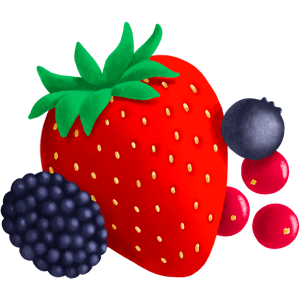
Nutrition is often regarded as the first form of medicine. Indeed, it plays a fundamental role in our health! This article presents 10 essential keys to adopting simple dietary habits that can optimize your health and well-being.
1. Have a savory breakfast!
Most of us eat cereal with milk or buttered white toast with jam alongside a tall glass of orange juice for breakfast. But that breakfast is far from ideal in terms of nutrition. Indeed, that kind of overly sugary meal encourages insulin secretion, which should be avoided — especially in the morning.
It’s best to opt for a savory breakfast. Eating protein in the morning promotes the production of dopamine, a neurotransmitter that stimulates the mind and jump-starts your motivation. In addition to making you more motivated and alert, consuming protein at breakfast can also help you feel full longer and reduce snacking later in the morning.
Eggs are the perfect solution because they contain extremely high quality protein and are rich in vitamins and minerals. But there are other protein sources you can try for variety:
 | Animal protein: one ounce of cheese (preferably goat or sheep milk), a yogurt (goat or sheep milk), sardines or a slice of good ham (from time to time) |
 | Plant-based protein: soy-based vegan pudding packed with protein, chia seeds, nuts (almonds, walnuts, hazelnuts, etc.) |
2. Eat at least 2 to 3 fruits and 2 to 3 servings of vegetables a day
A daily intake of 28 to 32 oz of fruit and vegetables is ideal, i.e. 2 to 3 servings of vegetables (17 oz) and 2 to 3 fruits. For lunch and dinner, choose at least one raw and one cooked fruit or vegetable.
After all, fresh fruits and vegetables are very high in fiber, which has an essential role to optimizing our health. It contributes to satiety and therefore plays an important role in weight management, it helps regulate our blood sugar levels, and it also facilitates digestion and helps balance our gut microbiota.
Fruits and vegetables are also rich in vitamins, minerals and antioxidants. Getting the right amount of antioxidants is particularly important for preventing cancer, degenerative diseases and cardiovascular disease.
Vary the fruits and vegetables on your plate and their colors as much as possible to reap all their benefits!
Warning: fruit juice is not the same as fruit! Juice lacks the fiber that regulates the rate at which sugars are assimilated, so its glycemic index is much higher than that of whole fruit.
3. Eat good fat
The quest to eliminate fat has no scientific or biological basis. In fact, “good fats” are responsible for the proper development of eyesight, brain membranes and neural connections. In addition to being good for the brain, they help reduce cardiovascular risks. So good fat is a crucial ally for good health!
But not all fats are created equal! The problem is not that we eat too much fat these days, but that we eat too much bad fat.
Limit your intake of saturated fats and omega-6, which are currently over-consumed. These fats are found in animal products (meat, butter, cheese, etc.), in some vegetable oils (sunflower, coconut, palm, grape seed) and above all in many processed products (cookies, potato chips, etc.).
On the other hand, make sure you get plenty of omega-3 fatty acids! Omega-3 fatty acids occur primarily in fatty fish (tuna, salmon, mackerel, sardines, etc.), certain oils (canola, linseed, walnut), seeds (chia, flax, hemp) and in some vegetables in very small quantities (watercress, lamb’s lettuce, cabbage). Caution: do not consume tuna or salmon more than once a week, as they generally contain high levels of various pollutants, including heavy metals (mercury, PCBs, dioxins, etc.).
Choose products rich in omega-9 fatty acids. Omega-9 fatty acids occur in large quantities in olive oil, hazelnut oil, avocado, hazelnuts and almonds. In view of the environmental impact of avocados, we recommend eating them only occasionally.
4. Take the time to chew
Chewing may seem like a trivial step and is often neglected; however, it plays an essential role in our health.
 | Better nutrient absorption: good chewing transforms food into nutrients that reach our cells more effectively. |
 | Eating less and managing weight: chewing triggers various hormones that send a satiety signal to the brain during the meal. |
 | Improving digestion: insufficient chewing forces the stomach to produce more gastric juice to break down large pieces. This excess acid can irritate the digestive lining and cause acid reflux. |
 | Protecting teeth and gums: chewing helps prevent cavities by stimulating saliva production, which cleans dental plaque and protects enamel from acidity. It also exercises our gums, essential for good dental health. |
5. Fill up on antioxidants
Antioxidants are extremely beneficial molecules that are crucial to cell protection. They help guard against various afflictions, such as premature skin aging, cancer, degenerative disorders, cataracts, arthritis and cardiovascular disease.
The good news is that these miracle workers occur all around us in our food. Eating generous amounts of fruits and vegetables is usually enough to cover the body’s needs. Here are some foods with particularly high antioxidant properties:
 | Berries: blueberries, blackberries, goji berries, acai berries, raspberries, strawberries |
 | Other fruits: apples, plums, pomegranates, oranges, kiwis, grapes, figs |
 | Vegetables: artichokes, cabbages, broccoli, spinach, bell peppers |
 | Allium family: onion, garlic, shallot |
 | Spices: cloves, ginger, turmeric, cinnamon |
 | Herb: thyme, basil, oregano, parsley, chives, dill, mint, rosemary, bay leaf |
 | Hot beverages: tea and coffee |
 | Cacao and chocolate: pure cocoa powder, dark chocolate (at least 70% cacao) |
You should eat organic versions of these foods because organically grown foods have 20% to 70% more polyphenols (a type of antioxidant found in many vegetables) than conventionally grown foods.
6. Eat mindfully
In our busy lives, many of us eat breakfast at breakneck speed, or gobble up lunch in front of our computers to make the most of our time. We are completely disconnected from our relationship with food.
However, it is important to devote at least 20 minutes to each meal. Mindfulness is about considering a moment in its own right, and paying attention to what we eat.
Applying mindfulness to our eating habits will have several beneficial impacts. First, it enables us to listen to our hunger and satiety signals and ensure that our intake is adapted to our needs. This will reduce the quantities we consume and our cravings for snacks.
Mindful eating also helps develop a preference for healthier foods: when we eat impulsively and emotionally without listening to our bodies, we no longer feel the pleasure of eating, and we are more susceptible to fatty, sweet and salty foods.
Finally, mindfulness also contributes to mental well-being. It allows you to observe your feelings without judgment, and to listen to yourself. Thinking only of the present moment during a meal also helps to still the mind and lower stress and anxiety.
7. Limit your salt intake
Salt is essential to proper body function, but excessive consumption can lead to the development of certain diseases. Today, we consume more than twice as much salt than we really need!
Excessive salt intake increases the risk of high blood pressure. Hypertension itself can lead to heart disease and even stroke. Salt consumption also increases the risk of cancer and stomach ulcers.
There are simple ways to reduce salt intake:
- Limit foods high in salt: ready-made meals, potato chips, cold cuts, pizza, sauces, cheese, etc.
- Opt for alternatives to add flavor to dishes, such as garlic, onion, thyme, chives, basil, lemon, pepper, curry, paprika and all sorts of spices.
- Taste before salting
- Do not add salt to cooking water
- Remove the salt shaker from the table
8. Go vegetarian at dinner
It is recommended to prepare a vegetarian dinner, meaning no meat, fish or eggs. This type of meal will help pave the way for a good night’s sleep.
So, for dinner you should opt for plant-based protein rather than animal protein. Indeed, animal protein encourages the production of dopamine, a neurotransmitter responsible for alertness and motivation. While it is perfect in the morning to rev you up, at night the body needs to make serotonin, a neurotransmitter associated with soothing and sleep regulation.
Serotonin is made from tryptophan, an amino acid found in plant-based protein, such as legumes, soy, brown rice, sunflower seeds and chocolate. The carbohydrates found in legumes and grain products also help optimize serotonin production.
Some foods promote serotonin production, which optimizes sleep quality:
 | Walnuts and almonds: in addition to tryptophan, they contain magnesium, a lack of which can be linked to sleep disorders. |
 | Carbohydrates (from whole grains and fruits): thanks to insulin secretion, their amino acids will be directed to the brain rather than the muscles. That will make room for tryptophan in the brain, so it is more readily available for serotonin production. |
Furthermore, animal proteins and cooked fats are very demanding for the digestive system: they are made up of molecules that can take a long time to digest.
9. Opt for low-temperature cooking
Cooking at high temperatures erodes the nutritional quality of food: it leads to the destruction of certain vitamins and minerals. Some vitamins are very sensitive to heat, and foods can easily lose 50% of their initial vitamin content during cooking. The longer the cooking time and the higher the temperature, the lower the nutritional content of the food.
In addition, browning food during cooking is accompanied by the production of Maillard bodies, compounds which, in excessive quantities, can increase the risk of developing certain cancers.
Opt for low-temperature cooking, i.e. below 210°F. The most useful method is gently steaming your foods.
10. Eat raw foods and avoid processed foods
Raw food is a product that is sold in its original form and has not undergone any
processing: fruit and vegetables, legumes, eggs, fish, etc. Conversely, processed products
are those that have undergone some form of transformation in order to be sold and which do not occur in this form in nature: ready-made meals, fruit juices and soft drinks, cookies, etc.
Ultra-processed foods have problematic health effects: they are often low in nutrients with a high glycemic load. What’s more, they generally contain little fiber and their texture can be too soft to be satiating.
Finally, consuming processed foods throws the gut microbiota out of balance. As a result, the intestinal microbiota has fewer good bacteria, which are essential to proper body function since they fight pathogens (e.g. parasites and bacteria) and perform essential functions to prevent lifestyle diseases.
Here are some tips for avoiding processed foods:
 | Go with short ingredient lists, meaning no more than 4 or 5 ingredients. |
 | Avoid products whose ingredient list includes items with complicated names (glucose-fructose syrup, hydrolyzed proteins, modified starch, etc.). |
 | Choose products without problematic additives. Of course, you can use Yuka for this! |
 | Eat as many raw, unprocessed products as possible, that you have prepared and cooked yourself. |
- Hu FB, Stampfer MJ, Rimm EB et al. A prospective study of egg consumption and risk of cardiovascular disease in men and women. JAMA. 1999;281:1387-1394.
- Vorster HH, Benade AJ, Barnard HC et al. Egg intake does not change plasma lipoprotein and coagulation profiles. Am J Clin Nutr. 1992;55:400-410.
- Katz DL, Evans MA, Nawaz H et al. Egg consumption and endothelial function: a randomized controlled crossover trial. Int J Cardiol. 2005;99:65-70.
- Howell WH, McNamara DJ et al. Plasma lipid and lipoprotein responses to dietary fat and cholesterol: a meta-analysis. Am J Clin Nutr. 1997;65:1747-1764.
- Krauss RM, Eckel RH, Howard B et al. AHA Dietary Guidelines: revision 2000: A statement for healthcare professionals from the Nutrition Committee of the American Heart Association. Stroke. 2000;31:2751-2766.
- Swanson D, Block R, Mousa SA. Omega-3 fatty acids EPA and DHA: health benefits throughout life. Adv Nutr. 2012 Jan;3(1):1-7. doi: 10.3945/an.111.000893. Epub 2012 Jan 5. Review.
- Nichols PD, McManus A, Krail K, Sinclair AJ, Miller M. Recent advances in omega-3: Health Benefits, Sources, Products and Bioavailability. Nutrients. 2014;6(9):3727–3733. Published 2014 Sep 16.
- Étude individuelle nationale des consommations alimentaires 3 (INCA 3) – Avis de l’Anses – Rapport d’expertise collective.
- Delgado GE, Krämer BK, Lorkowski S, März W, von Schacky C, Kleber ME. Individual omega-9 monounsaturated fatty acids and mortality-The Ludwigshafen Risk and Cardiovascular Health Study. J Clin Lipidol. 2017 Jan – Feb;11(1):126-135.e5
- Flood-Obbagy, J. E.; Rolls, B. J. The Effect of Fruit in Different Forms on Energy Intake and Satiety at a Meal. Appetite 2009, 52 (2), 416–422.
- Dagfinn Aune, Edward Giovannucci, Paolo Boffetta, Lars T. Fadnes, NaNa Keum, Teresa Norat, Darren C. Greenwood, Elio Riboli, Lars J. Vatten, Serena Tonstad. Fruit and vegetable intake and the risk of cardiovascular disease, total cancer and all-cause mortality–a systematic review and dose-response meta-analysis of prospective studies. International Journal of Epidemiology, 2017; DOI: 10.1093/ije/dyw319
- Tavoularis G., Hébel P., «Fruits et légumes : les Français suivent de moins en moins la recommandation», in: Consommations et modes de vies, CREDOC, n°292, ISSN 0295-9976, Juillet 2017
- Etude NutriNet-Sante : https://info.etude-nutrinet-sante.fr/protectednew/pdf/DOSSIER_PRESSE_Nutrinet-Sante_22_11_12.pdf
- Feder D, Fonseca FLA. Chapter 2 – The Mechanism of Fiber Effects on Insulin Resistance. In: Samaan RA, ed. Dietary Fiber for the Prevention of Cardiovascular Disease. Academic Press; 2017:23-33.
- Patel S. Anti-Obesity and Anti-Diabetes Foods: High Fibre Diets. In: Melton L, Shahidi F, Varelis P, eds. Encyclopedia of Food Chemistry. Oxford: Academic Press; 2019:248-252.
- De Vadder F, Kovatcheva-Datchary P, Goncalves D, Vinera J, Zitoun C, Duchampt A, Bäckhed F, Mithieux G. Microbiota-generated metabolites promote metabolic benefits via gut-brain neural circuits. Cell. 2014 Jan 16;156(1-2):84-96.
- Threapleton DE, Greenwood DC, Evans CE, Cleghorn CL, Nykjaer C, Woodhead C, Cade JE, Gale CP, Burley VJ. Dietary fibre intake and risk of cardiovascular disease: systematic review and meta-analysis. BMJ. 2013 Dec 19;347:f6879.
- Imai S, Fukui M, Kajiyama S. Effect of eating vegetables before carbohydrates on glucose excursions in patients with type 2 diabetes. J Clin Biochem Nutr. 2014 Jan;54(1):7-11.
- BROWNLEE, Iain A., CHATER, Peter I., PEARSON, Jeff P., et al. Dietary fibre and weight loss: Where are we now?. Food Hydrocolloids, 2017, vol. 68, p. 186-191.
- Chandalia M, Garg A, Lutjohann D, von Bergmann K, Grundy SM, Brinkley LJ.
- Beneficial effects of high dietary fiber intake in patients with type 2 diabetes mellitus. N Engl J Med. 2000 May 11;342(19):1392-8.
- Kim Y, Je Y. Dietary fibre intake and mortality from cardiovascular disease and all cancers: A meta-analysis of prospective cohort studies. Arch Cardiovasc Dis. 2016 Jan;109(1):39-54.
- Siri-Tarino, P. W., Sun, Q., Hu, F. B., & Krauss, R. M. (2010). Saturated fat, carbohydrate, and cardiovascular disease. The American journal of clinical nutrition, 91(3), 502-509.
- DiNicolantonio JJ, Lucan SC, O’Keefe JH. The Evidence for Saturated Fat and for Sugar Related to Coronary Heart Disease. Prog Cardiovasc Dis. 2016 Mar-Apr;58(5):464-72. doi: 10.1016/j.pcad.2015.11.006. Epub 2015 Nov 14. Review.
- Patterson E, Wall R, Fitzgerald GF, Ross RP, Stanton C. Health implications of high dietary omega-6 polyunsaturated Fatty acids. J Nutr Metab. 2012;2012:539426.
- Innes JK, Calder PC. Omega-6 fatty acids and inflammation. Prostaglandins Leukot Essent Fatty Acids. 2018 May;132:41-48. doi: 10.1016/j.plefa.2018.03.004. Epub 2018 Mar 22. Review.
- Simopoulos AP. The importance of the ratio of omega-6/omega-3 essential fatty acids. Biomed Pharmacother. 2002 Oct;56(8):365-79. Review. PubMed PMID: 12442909.
- Simopoulos AP. An Increase in the Omega-6/Omega-3 Fatty Acid Ratio Increases the Risk for Obesity. Nutrients. 2016;8(3):128. Published 2016 Mar 2.
- DiNicolantonio JJ, O’Keefe JH. Importance of maintaining a low omega-6/omega-3 ratio for reducing inflammation. Open Heart. 2018;5(2):e000946. Published 2018 Nov 26.
- de Lorgeril M, Salen P. New insights into the health effects of dietary saturated and omega-6 and omega-3 polyunsaturated fatty acids. BMC Med. 2012;10:50. Published 2012 May 21.
- Bernard, Carole & Vanduffel, Steven & Ye, Jiang, 2019. « Optimal strategies under Omega ratio, » European Journal of Operational Research, Elsevier, vol. 275(2), pages 755-767.
- Dhaka V, Gulia N, Ahlawat KS, Khatkar BS. Trans fats-sources, health risks and alternative approach – A review. J Food Sci Technol. 2011;48(5):534–541.
- Iqbal MP. Trans fatty acids – A risk factor for cardiovascular disease. Pak J Med Sci. 2014;30(1):194–197.
- Mozaffarian D, Aro A, Willett WC. Health effects of trans-fatty acids: experimental and observational evidence. Eur J Clin Nutr. 2009 May;63 Suppl 2:S5-21.
- Shah B, Thadani U. Trans fatty acids linked to myocardial infarction and stroke: What is the evidence? Trends Cardiovasc Med. 2019 Jul;29(5):306-310. doi: 10.1016/j.tcm.2018.09.011. Epub 2018 Sep 19. Review. PubMed PMID: 31130187.
- Okubo H, Murakami K, Masayasu S, Sasaki S. The Relationship of Eating Rate and Degree of Chewing to Body Weight Status among Preschool Children in Japan: A Nationwide Cross-Sectional Study. Nutrients. 2018;11(1):64. Published 2018 Dec 29.
- Zhu Y, Hollis JH. Relationship between chewing behavior and body weight status in fully dentate healthy adults. Int J Food Sci Nutr. 2015 Mar;66(2):135-9.
- Ashiga H, Takei E, Magara J, et al. Effect of attention on chewing and swallowing behaviors in healthy humans. Sci Rep. 2019;9(1):6013. Published 2019 Apr 12.
- N’gom PI, Woda A. Influence of impaired mastication on nutrition. J Prosthet Dent. 2002;87(6):667-673.
- Mann T, Heuberger R, Wong H. The association between chewing and swallowing difficulties and nutritional status in older adults. Aust Dent J. 2013;58(2):200-206.
- Furuta M, Yamashita Y. Oral Health and Swallowing Problems. Curr Phys Med Rehabil Rep. 2013;1(4):216-222. Published 2013 Sep 15.
- Furuta M, Komiya-Nonaka M, Akifusa S, Shimazaki Y, Adachi M, Kinoshita T, Kikutani T, Yamashita Y. Interrelationship of oral health status, swallowing function, nutritional status, and cognitive ability with activities of daily living in Japanese elderly people receiving home care services due to physical disabilities. Community Dent Oral Epidemiol. 2013 Apr;41(2):173-81.
- Miquel-Kergoat S, Azais-Braesco V, Burton-Freeman B, Hetherington MM. Effects of chewing on appetite, food intake and gut hormones: A systematic review and meta-analysis. Physiol Behav. 2015 Nov 1;151:88-96.
- Crinnion WJ. Organic foods contain higher levels of certain nutrients, lower levels of pesticides, and may provide health benefits for the consumer. Altern Med Rev. 2010 Apr;15(1):4-12. Review.
- Barański M, Srednicka-Tober D, Volakakis N, Seal C, Sanderson R, Stewart GB, Benbrook C, Biavati B, Markellou E, Giotis C, Gromadzka-Ostrowska J, Rembiałkowska E, Skwarło-Sońta K, Tahvonen R, Janovská D, Niggli U, Nicot P, Leifert C. Higher antioxidant and lower cadmium concentrations and lower incidence of pesticide residues in organically grown crops: a systematic literature review and meta-analyses. Br J Nutr. 2014 Sep 14;112(5):794-811.
- https://presse.inserm.fr/moins-de-cancers-chez-les-consommateurs-daliments-bio/32820/
- Morillo Sarto H, Barcelo-Soler A, Herrera-Mercadal P, et al. Efficacy of a mindful-eating programme to reduce emotional eating in patients suffering from overweight or obesity in primary care settings: a cluster-randomised trial protocol. BMJ Open. 2019;9(11):e031327. Published 2019 Nov 21.
- Mantzios M. Editorial: Mindfulness and Eating Behavior. Front Psychol. 2018;9:1986. Published 2018 Oct 12.
- O’Reilly GA, Cook L, Spruijt-Metz D, Black DS. Mindfulness-based interventions for obesity-related eating behaviours: a literature review. Obes Rev. 2014;15(6):453-461.
- Warren JM, Smith N, Ashwell M. A structured literature review on the role of mindfulness, mindful eating and intuitive eating in changing eating behaviours: effectiveness and associated potential mechanisms. Nutr Res Rev. 2017;30(2):272-283.
- Godfrey KM, Gallo LC, Afari N. Mindfulness-based interventions for binge eating: a systematic review and meta-analysis. J Behav Med. 2015;38(2):348-362.
- Friedman M. Analysis, Nutrition, and Health Benefits of Tryptophan. Int J Tryptophan Res. 2018;11:1178646918802282. Published 2018 Sep 26.
- Jenkins TA, Nguyen JC, Polglaze KE, Bertrand PP. Influence of Tryptophan and Serotonin on Mood and Cognition with a Possible Role of the Gut-Brain Axis. Nutrients. 2016;8(1):56. Published 2016 Jan 20.
- Troynikov O, Watson CG, Nawaz N. Sleep environments and sleep physiology: A review. J Therm Biol. 2018 Dec;78:192-203.
- Tavoularis G., Hébel P., «Fruits et légumes : les Français suivent de moins en moins la recommandation», in: Consommations et modes de vies, CREDOC, n°292, ISSN 0295-9976, Juillet 2017
- Aune et al, Dietary fibre, whole grains, and risk of colorectal cancer: systematic review and dose-response meta-analysis of prospective studies. BMJ 2011.
- Ötles et Ozgoz. 2014. « Health effects of dietary fiber ». Acta Sci Pol, Tech Aliment 191-202.
- Y. Zhu, W. Ling, H. Guo, F. Song, Q. Ye, T. Zou, D. Li, Y. Zhang, G. Li, Y. Xiao, F. Liu, Z. Li, Z. Shi, Y. Yang. Anti-inflammatory effect of purified dietary anthocyanin in adults with hypercholesterolemia: A randomized controlled trial. Nutrition, Metabolism and Cardiovascular Diseases, Available online 17 August 2012, ISSN 0939-4753, 10.1016/j.numecd.2012.06.005.
- Lee S, Choi Y, Jeong HS, Lee J, Sung J. Effect of different cooking methods on the content of vitamins and true retention in selected vegetables. Food Sci Biotechnol. 2017;27(2):333-342. Published 2017 Dec 12.
- Jiménez-Monreal AM, García-Diz L, Martínez-Tomé M, Mariscal M, Murcia MA. Influence of cooking methods on antioxidant activity of vegetables. J Food Sci. 2009;74(3):H97-H103.
- Yuan GF, Sun B, Yuan J, Wang QM. Effects of different cooking methods on health-promoting compounds of broccoli. J Zhejiang Univ Sci B. 2009;10(8):580-588.
- Bastías JM, Balladares P, Acuña S, Quevedo R, Muñoz O. Determining the effect of different cooking methods on the nutritional composition of salmon (Salmo salar) and chilean jack mackerel (Trachurus murphyi) fillets. PLoS One. 2017;12(7):e0180993. Published 2017 Jul 7.
- Andlauer W, Stumpf C, Hubert M, Rings A, Fürst P. Influence of cooking process on phenolic marker compounds of vegetables. Int J Vitam Nutr Res. 2003;73(2):152-159.
- Ferracane R, Pellegrini N, Visconti A, et al. Effects of different cooking methods on antioxidant profile, antioxidant capacity, and physical characteristics of artichoke. J Agric Food Chem. 2008;56(18):8601-8608.
- Carcinogens in Tobacco Smoke: Benzo[a] pyrene from Canadian Cigarettes and Cigarette Tobacco, M.J.Kaisennan, W. S.Rickert, American Journal of Public Health, 1992
- Analysis of 200 food items for benzo[a] pyrene and estimation of its intake in an epidemiologic study, N.Kazerounia et al, Food and Chemical Toxicology 39, 2000
- EFSA – https://www.efsa.europa.eu/fr/efsajournal/pub/4104
- INFOSAN – https://www.who.int/foodsafety/fs_management/No_02_Acrylamide_Mar05_fr_rev1.pdf
- Anses – L’acrylamide dans les aliments : https://www.anses.fr/fr/content/l%E2%80%99acrylamide-dans-les-aliments
- Parada H Jr, Steck SE, Bradshaw PT, et al. Grilled, Barbecued, and Smoked Meat Intake and Survival Following Breast Cancer. J Natl Cancer Inst. 2017;109(6):djw299. Published 2017 Jan 5.
- Uribarri J, Woodruff S, Goodman S, et al. Advanced glycation end products in foods and a practical guide to their reduction in the diet. J Am Diet Assoc. 2010;110(6):911-16.e12.
- Tamanna N, Mahmood N. Food Processing and Maillard Reaction Products: Effect on Human Health and Nutrition. Int J Food Sci. 2015;2015:526762.
- Trevisan AJ, de Almeida Lima D, Sampaio GR, Soares RA, Markowicz Bastos DH. Influence of home cooking conditions on Maillard reaction products in beef. Food Chem.
- Virk-Baker MK, Nagy TR, Barnes S, Groopman J. Dietary acrylamide and human cancer: a systematic review of literature. Nutr Cancer. 2014;66(5):774-790.
- Brownlee M. Advanced protein glycosylation in diabetes and aging. Annu Rev Med. 1995;46:223-234.
- Anne Moorhead, S.; Welch, R. W.; Barbara, M.; Livingstone, E.; McCourt, M.; Burns, A. A.; Dunne, A. The Effects of the Fibre Content and Physical Structure of Carrots on Satiety and Subsequent Intakes When Eaten as Part of a Mixed Meal. Br. J. Nutr. 2006, 96 (3), 587–595.
- Haber, G. B.; Heaton, K. W.; Murphy, D.; Burroughs, L. F. Depletion and Disruption of Dietary Fibre. Effects on Satiety, Plasma-Glucose, and Serum-Insulin. Lancet 1977, 2 (8040), 679–682.
- Flood-Obbagy, J. E.; Rolls, B. J. The Effect of Fruit in Different Forms on Energy Intake and Satiety at a Meal. Appetite 2009, 52 (2), 416–422.
- Gustafsson, K.; Asp, N. G.; Hagander, B.; Nyman, M.; Schweizer, T. Influence of Processing and Cooking of Carrots in Mixed Meals on Satiety, Glucose and Hormonal Response. Int J Food Sci Nutr 1995, 46 (1), 3–12.
- Lioger, D.; Fardet, A.; Foassert, P.; Davicco, M.-J.; Mardon, J.; Gaillard-Martinie, B.; Remesy, C. Influence of Sourdough Prefermentation, of Steam Cooking Suppression and of Decreased Sucrose Content during Wheat Flakes Processing on the Plasma Glucose and Insulin Responses and Satiety of Healthy Subjects. J Am Coll Nutr 2009, 28 (1), 30–36.
- Burton, P.; Lightowler, H. J. Influence of Bread Volume on Glycaemic Response and Satiety. Br. J. Nutr. 2006, 96 (5), 877–882.
- Bligh, H. F. J.; Godsland, I. F.; Frost, G.; Hunter, K. J.; Murray, P.; MacAulay, K.; Hyliands, D.; Talbot, D. C. S.; Casey, J.; Mulder, T. P. J.; et al. Plant-Rich Mixed Meals Based on Palaeolithic Diet Principles Have a Dramatic Impact on Incretin, Peptide YY and Satiety Response, but Show Little Effect on Glucose and Insulin Homeostasis: An Acute-Effects Randomised Study. Br. J. Nutr. 2015, 113 (4), 574–584.
- Bleiweiss-Sande, R.; Chui, K.; Evans, E. W.; Goldberg, J.; Amin, S.; Sacheck, J. Robustness of Food Processing Classification Systems. Nutrients 2019, 11 (6).
- Fardet, A.; Rock, E. Perspective: Reductionist Nutrition Research Has Meaning Only within the Framework of Holistic and Ethical Thinking. Adv Nutr 2018, 9 (6), 655–670.
- Louzada, M. L. da C.; Ricardo, C. Z.; Steele, E. M.; Levy, R. B.; Cannon, G.; Monteiro, C. A. The Share of Ultra-Processed Foods Determines the Overall Nutritional Quality of Diets in Brazil. Public Health Nutr 2018, 21 (1), 94–102.
- Moubarac JC, Batal M, Louzada ML, Martinez Steele E, Monteiro CA. Consumption of ultra-processed foods predicts diet quality in Canada. Appetite. 2017;108:512-520.
- Rauber, F.; Louzada, M. L. da C.; Steele, E. M.; Millett, C.; Monteiro, C. A.; Levy, R. B. Ultra-Processed Food Consumption and Chronic Non-Communicable Diseases-Related Dietary Nutrient Profile in the UK (2008–2014). Nutrients 2018, 10 (5).
- Machado, P. P.; Steele, E. M.; Levy, R. B.; Sui, Z.; Rangan, A.; Woods, J.; Gill, T.; Scrinis, G.; Monteiro, C. A. Ultra-Processed Foods and Recommended Intake Levels of Nutrients Linked to Non-Communicable Diseases in Australia: Evidence from a Nationally Representative Cross-Sectional Study. BMJ Open 2019, 9 (8), e029544.
- Martínez Steele E, Popkin BM, Swinburn B, Monteiro CA. The share of ultra-processed foods and the overall nutritional quality of diets in the US: evidence from a nationally representative cross-sectional study. Popul Health Metr. 2017;15(1):6. Published 2017 Feb 14.
- Fardet, A. Characterization of the Degree of Food Processing in Relation With Its Health Potential and Effects. Adv. Food Nutr. Res. 2018, 85, 79–129.
- Costa, C. S.; Del-Ponte, B.; Assunção, M. C. F.; Santos, I. S. Consumption of Ultra-Processed Foods and Body Fat during Childhood and Adolescence: A Systematic Review. Public Health Nutr 2018, 21 (1), 148–159.
- Srour B, Fezeu LK, Kesse-Guyot E, et al. Ultra-processed food intake and risk of cardiovascular disease: prospective cohort study (NutriNet-Santé). BMJ. 2019;365:l1451. Published 2019 May 29.
- Costa, C. S.; Del-Ponte, B.; Assunção, M. C. F.; Santos, I. S. Consumption of Ultra-Processed Foods and Body Fat during Childhood and Adolescence: A Systematic Review. Public Health Nutr 2018, 21 (1), 148–159.
- Hall KD, Ayuketah A, Brychta R, et al. Ultra-Processed Diets Cause Excess Calorie Intake and Weight Gain: An Inpatient Randomized Controlled Trial of Ad Libitum Food Intake [published correction appears in Cell Metab. 2019 Jul 2;30(1):226]. Cell Metab. 2019;30(1):67-77.e3.
- Vandevijvere, S.; Jaacks, L. M.; Monteiro, C. A.; Moubarac, J.-C.; Girling-Butcher, M.; Lee, A. C.; Pan, A.; Bentham, J.; Swinburn, B. Global Trends in Ultraprocessed Food and Drink Product Sales and Their Association with Adult Body Mass Index Trajectories. Obes Rev 2019, 20 Suppl 2, 10–19.
- Nardocci, M.; Leclerc, B.-S.; Louzada, M.-L.; Monteiro, C. A.; Batal, M.; Moubarac, J.-C. Consumption of Ultra-Processed Foods and Obesity in Canada. Can J Public Health 2019, 110 (1), 4–14
- Chambers, Lucy. (2016). Food texture and the satiety cascade. Nutrition Bulletin. 41. 277-282. 10.1111/nbu.12221.
- Tremblay, A.; Bellisle, F. Nutrients, Satiety, and Control of Energy Intake. Appl Physiol Nutr Metab 2015, 40 (10), 971–979.
- Fardet, A. Minimally Processed Foods Are More Satiating and Less Hyperglycemic than Ultra-Processed Foods: A Preliminary Study with 98 Ready-to-Eat Foods. Food Funct 2016, 7 (5), 2338–2346.
- Fiolet, T.; Srour, B.; Sellem, L.; Kesse-Guyot, E.; Allès, B.; Méjean, C.; Deschasaux, M.; Fassier, P.; Latino-Martel, P.; Beslay, M.; et al. Consumption of Ultra-Processed Foods and Cancer Risk: Results from NutriNet-Santé Prospective Cohort. BMJ 2018, 360.
- Zinöcker, M. K.; Lindseth, I. A. The Western Diet–Microbiome-Host Interaction and Its Role in Metabolic Disease. Nutrients 2018, 10 (3).







Just want say THANK YOU Your Helping my nephew reverse his diabetes
Very useful article and a fantastic app. I made a point of having a paid subscription with you because I think you app is a health game-changer and I applaud that you’re not affiliated to any food or products companies – therefore I hope that my subscription goes some way to supporting you as more than ever we need the independents.
Very useful article. When I first used Yuka . Nearly Everything I was about to buy was bad for me !! The big advantage of Yuka is that I can immediately see the alternatives. I haven’t changed everything but I am now more in control of my eating . More to do in 2026 . Thank you Yuka
i would be lost without my yuka app . having read ultra processed people three times by chris van tulleken has been a revelation too
Thank you for this very helpful article❤️
I joined Yuka about 6 months ago and it has been life-changing!! I’ve always been really interested in healthy living (thanks to my mother who has just turned 97) and this app makes it so simple to know the best products to buy – not only what goes into our body but also what we put on it.
Question why sports people when they carry a bottle of water and they always end up pinch of sea salt is it good or bad? I find out since I start doing the sign I felt much better. I think less fluid my energy I feel good.
Awesome – love this info and will take note and also send to my friends starting a new year eating healthier!
I would like MSG added to the system
Great article. The Yukka app has really opened my eyes to the poison we are being fed in our foods! The food indusrty really need to be held accountable and regulated a hell of a lot more. The app is briliant and we scan everything now.
Great article and love the Yuka app, definitely worth joining. I use it everyday and has definitely changed what I eat and drink to make more healthier choices.
I am glad I took the time to read this – learned lots.
I love the app and have been seriously considering joining Yuka.
Thank you very much for sharing this information, very helpful.the yuka app is Awesome,it was helpful me be more mindful when shopping. Really appreciated.
I find the yuka app has helped me tremendously.
A lot of things I bought because of the brand were awful 😖 now I check products all the time. Thanks so much.
I really appreciate YUKA. I’m vegan, and it has really changed the way I shop. I make sure I have the app with me whenever I leave home. Thank you.
Thank you for sharing this information. This was very helpful and insightful.
This is greaat and very helpful information. Thank you for sharing and raising our awareness to the benefits of healthier food selections.
Very helpful! Particularly mindful eating. So true! Thank you.
Thank you for this information. I am classed as pre-diabetic which is worrying, but with your app i will be able to recognise the Goodies from the Baddies.
Thank you so much for sharing all this information. Still loving using the app when shopping brilliant
Everything is good
Very useful article which I follow all the time, that’s probably why I am never ill, never had flu in my life. My favourite snacks are
walnuts and dark chocolate and dare I say it a little red wine on rare occasions. Thanks as always for sharing your great info. 👍
Good advice lots I am aware of but quite a few things I was totally unaware of so thankyou
Good advice mostly. Chewing and whole grains are the jey maybe . Thanks to new info too….
I only eat what I make myself i don’t eat seed oils sugar or refined carbs now that I have Yuka i can see what they put in the food i buy thanks
Brilliant. Lots of essential information to guide you through the healthy diet. I just wish more of the healthy products were cheaper to buy for families. The supermarket chains should increase buy one get one free of healthy options .
Hi. A big thank you for your good advice over the past few months. I was introduced to Yuka by a friend and initially used it to help me make better decisions about my food however I have started to use it for my beauty products which is amazing 🤩. Thank you again and keep up the good work.
A friend told me about Yuka, and now I use it all the time. Have recommended it to lots of people, including strangers in supermarkets. Very helpful and informative. Like the way you recommend healthier alternatives too. Thankyou!
Thank you for all you do to keep me updated and inform about how and what to eat .soooo very greatfull. 😊😋
Am I on a vegetarian forum. This is very anti meat. Meat contains everything you need for an healthy life. Do we really need all this fiber in our food. What studies actually prove this where did that come from?
A great article re ten tips for healthy eating. We all need to be more aware of what’s in our food and be responsible for our own lifestyle. I love the app and recommend it to all of my friends and family. Keep up the good work 🏆
I started using the Yuka app in April 2025, and I love it. I refer people to Yuka all the time, even to strangers in an aisle debating what they should buy. I have subscribed to the premium version and have found it such a great help when searching for particular products. Thank you and keep up the good work! Now to get the US on track with European guidelines. 🙂
I joined last year and Love this app, use it all the time cannot recommend it highly enough
please keep up the great work your information is life changing
Thank you
Great article thank you
I don’t add salt to cooking and steam veg
Salt like sugar is very addictive
Brilliant! And good advice 😊
Yuka is so good for helping with this.
Hi, great article but just to point out that (under item 8) eggs are vegetarian.
This is becoming a bit much now. I use the app (and I love it) to stay away from the additives, E numbers and chemicals they put in our food but if I follow the above there is little point to life! Don’t salt water? Have you ever tasted unsalted boiled pasta? Ever looked at how appealing boiled chicken breast is with no colouring on it? Eat certain fish BUT only once a week? Limit butter, but that a good fat in comparison to chemically induced margarine/’low fat’ spreads!
You need to start focusing more on the real issues: Processed foods and the bigger killer, Ultra processed foods, the chemicals in our food and sweeteners. The shift the focus to fresh veg, fruit and salads, then the one day a week vegetarian, etc etc. You are starting to get the messaging wrong.
I think yuka is run by vegetarians as they push you away from meat. Nothing good was said about meat.
Meat contains everything we need for a healthy life.
Are you a butcher?
Loved this article… always good to have a reminder of what foods to eat and how best to prepare and eat them. Thank you!
A straight forward way to aid our health which makes sense!! Love Yuka
Love the education !!! Can you explain the point, do not add salt to cooking water?
Why not and when should it be done.
Thank you
I think bc even if want to add the salt later, it’s just one way to reduce adding salt that may be unnecessary. That’s why it says “taste before you add” or something along those lines in the article.
Great advice, thank you. Absolutely love Yuka and have even got my grandchildren “Yukaing” things which is great for teaching them healthy eating
Yuka is brilliant. My nephew gave to my sister and I. I love it. Thank you
Excellent interesting content , thank you I love Yuka for its none complicated, science based advise …. I use your app regularly even as I am now on holiday in Spain such great coverage
Informative article- and I love your app. It’s the thing that keeps my husband and I nutritionally safe since we moved to America, thank you!
Small correction. My husband and me, not my husband and I. If you take the word husband out you wouldn’t say “that keeps I nutritionally safe”, you would say that keeps me nutritionally safe, that’s how you know. Sorry, I’m just anal about these things.
Extremely helpful guidance in living a healthier lifestyle, can’t imagine how we managed without YUKA.
A very useful and informative article, and love the app which is really helpful in making good choices of both food and cosmetics.
Some great advice here, I agree with all of them, I would perhaps ad an extra key of eating fermented food for a better guy health which affects you physical and mental health
You do a great job enforcing what we have always tried to achieve. We use your app extensively, and are constantly amazed by the results thank you
This is extremely useful and very information.
Mrs Conrad
Brilliant advice, thank you. Yuka is my go-to app for buying food. Just scan the bar code: it couldn’t be easier.
I find that the app etc are all very useful – I find that the hints are all useful – Thanks 👍
Yuka has enabled me to ear more healthy food and I no longer suffer from reflux and cholesterol levels getting better since watching intake of saturated fats.
Thank you
Thank you, a very helpful timely reminder 😊
Love this app,had for about 3 years now and never go shopping without using it,game changer.
Yuka has been so helpful to me, changing to a more healthy diet and being able to check what I’m buying is good or bad, also offering an alternative is great, I’m feeling the benefits and no longer need the prescribed medication. I love Yuka !
Yuka is my favorite app.
I recommend to family friends and complete strangers shopping. You’re totally brilliant, thank you xxx
This is brilliant, thank you. It confirms what I know and what I have been learning recently from What’s Up Docs podcasts, as well as a few new things.
Thank you for this.
Really useful article.
Has my membership finished do I have to renew each year?
Thanks Yuka, such a brilliant valuable app
The dietary guidelines from your sources that you refer to are outdated and obsolete
(Krauss RM, Eckel RH, Howard B et al. AHA Dietary Guidelines: revision 2000: A statement for healthcare professionals from the Nutrition Committee of the American Heart Association. Stroke. 2000;31:2751-2766.)
I’m finding animal protein, animal fats, minimal carbohydrates, no highly processed food of any type, no seed oils, no fruit and sparingly vegetables and salads are doing wonders for me. I’ve been on this for over seven months, eating a huge breakfast, two meals a day and lost 15 kilograms of weight without even trying to
But rapid weight loss isn’t usually a sign of good health. And animal proteins have a proven link to Alzheimers. I think you’re following a dangerous path, but obviously it’s your choice. Good luck 🙂
Agreed. Recommending seed oils and vegetarian? Really poor advice.
I too have removed carbs and increased healthy fats. No seed oils, fruit and no processed food at all. Not quite carnivore, more a modified keto diet. And weight has dropped off me too.
Looks like things are changing. Those food pyramids will be laughed at in a few years.
Thank you for those 10 tips to better diet !
I enjoy reading about the food items that you talk about as I am still modifying and experimenting with the different foods around.
I love Yuka and I have introduced it to lots of women in my circle. Yuka is a blessing. Thank you Yuka.
I am thrilled to be able to use your Yuka App, as I can now make informed decisions on purchasing products from the supermarket. I look forward to more people becoming aware and getting involved with healthy choices, so the manufacturers will become more responsible and hopefully feed us food not trans fats and chemicals.
I would just like to thank you for the valuable information that has helped change my gut problems. My diet always been healthy however Yuka app has highlighted foods that don’t support gut and now understand why the reason.
I use the Yuka app so often, especially when purchasing skincare, body care and even dental products. Previous skin care and make up labels that mark themselves as natural were one of the worst ratings, which I found fascinating. I love taking my app around the supermarket and I’m learning all the times. I always share products with my friends that they tell me are healthy and when I see them and scan them, they are quite shocked.
Keep up the great work.
Our body needs healthy salt i.e. Celtic, sea salt or Himalayan, as opposed to regular processed table salt which is bad for us.
Salt must not be demonized.
I 100% agree Lynda.
I find your advice so logical, easy to follow. I am 84, my husband 82, eating well is so important to us.
My husband and adult kids have eaten a plant-based diet for over ten years now, and I am so grateful that you always include plant-based options and that I can filter for vegan foods. I would say we know more about nutrition than most lay people because we really researched when converting to a plant/based diet, but I am always surprised by how much I DON’T know, so thank you for your insightful and practical eating tips! And that you include so much Australian product! I have also completely changed all my personal care and beauty products since using Yuka- love it.
Some excellent advice however grass-fed saturated fats are essential for brain development and nerve functioning. Highly processed canola oil is a poison originally designed as a lubricant for machinery, not for humans.
Eating blueberries and other berries is now a serious health hazard as they are bombarded with toxic chemicals which are very harmful to small children due to the proportionality of consumption.
Salt comes in many forms and not all salts are deleterious. Marine salts contain many minerals and elements not found in processed salts.
Love the app and science base advice
Thank you
I absolutely love this app, since I was told about it. I don’t eat much processed food, but checking items’ barcodes and finding out the truth of some so called healthy foods has been eye opening. For this reason I’ve changed from some products.
I also didn’t know about #8. I sleep well but will pass thin on to a friend.
Many thanks Yuka.
I thoroughly enjoyed reading this. Very informative. Lots of things I’m already trying to thanks to Yuka.
Can Yuka update its barcode reader so it can read the new barcodes now used progressively more across the product range by Woolworths in Australia?
Excellent health information, thank you to the Yuka team 😍
My favourite app EvErrrr 🫶🐾
I would love a section that if I typed in a product say healthy ice block it provided a list which includes only excellent plus the percentage. Ok plastics I know but I’m sure all Yuka users do our best x
Keep up the amazing work and how do I donate a second time as I didn’t realise how useful I would find this app 🫶🐾🐕
Ta
Very helpful app
Simple to use
I love Yuka ❤️ it gives me the right decision to allow me to eat better. Thank you 😊 🙏
Excellent been eating healthy for a while now .
Thank you very impressed.
Thank you so much. I am aware of many items of healthy food, but l still have learnt so much in the detailed in this information.
The Yuka app has saved me many times from buying food, labelled as healthy but often loaded with sugar. Thank you so much.
Maltodextrin is much worse than Sugar ” some info – there is no requirement to label it on food. 10 times worse than sugar . FDA and CDC classify as GRAS = Generally Regarded As Safe. Read about it. https://8fit.com/nutrition/what-is-maltodextrin-side-effects-and-dangers/
Thank you, Yuka, for all the health tips and advice. You’ve made life healthier by helping to understand what our bodies need to stay well.
Thank you for sharing all your great information. It is very helpful/ precise.
There is one problem for me however.
I am not an advocate for Canola oil. It’s a toxic oil. You have mentioned it as being ok to consume?
Olive oil and Avocado oil have not been mentioned, yet these are, to my mind excellent oils.. I will not purchase foods containing Canola oil.. and it seems to be in everything! I’m interested in the information you have regarding Canola oil to deem it as ok ?
Many Thanks
Pamela
Olive oil was mentioned at end of 3 fat section and I feel was covered in s positive way.
The Avocado effect on our land I will learn NOW as just planted three I grew from seed and hope I’m doing the right thing 🫶🐾
I agree with you Pamela. I do not like eating anything with Canola oil and yet there is soooo much canola oil in everything even things like almond milks and yet states that it is excellent. Would like to see more breakdown of items without canola oil.
I love the Yuka app, it is helping in making healthy choices when shopping. The healthy eating information is also helpful , knowledge is power, thankyou.
Enjoyed reading!
Thank you 🙏
Chocolate
Great advice
Very good advice to keep healthy
Concise and informative Thanks
Excellent summery of the basics for good foods to include in daily diet
Great article. Thanks for all this valuable information!! I can never learn enough but this is a perfect understandable guideline I can easily refer to.
The concept of eating a vegetable-based meal in the evening is new to me (as is cooking at lower temperatures).
While this is practical at weekends when we’re all likely to be home together to have a sit down meal at lunch time, this isn’t an option in the week when out at school/college/work.
Besides, while my husband and I would happily sit down to a vegetable-based dish, I don’t imagine our teens would be crazy about it!
Good information about daily eating habits. Easy to understand and pass on yo others for better shopping and eating choices. Brilliant.
I enjoyed the article and also learned a lot
Thank you for sharing . It makes a difference in my eating habits.
Thank you for sharing
I was aware of all this except for #8 (focus on eating serotonin rather than dopamine foods). I learned something new. Perhaps this is the answer to my insomnia. Thank you so much for all the helpful tips.
Lastly, this is very much in line with the most recent food pyramid except your article provides a lot more detailed information. Thanks again!
Thank you for all the tips. So important!
You are my Hero!
Excellent advice , people’s busy lives dictate sometimes their eating habits , but getting this advice out there is so important
Great advice for all
You suggested eating avocados only occasionally due to the environmental impact. Can you tell me more about this environmental impact and what is involved?
Thanks for the essential reminders re all around good health. #9 in the list – cooking at low temperatures – this I hadn’t heard and need to look at further, especially since many recipes include browning meat before putting in a slow cooker.
I have read all your information. Thank you . This app does improve my shopping list and not wasting my budget. All the cosmetic I purchase were alarming my health. I dont know if those lipstick did effects my tyroid. Because the sympton did mentioned will caused. Now I am in severe pain that I have to do biopsy. I have been using this lipstick for quite sometime.
I love my Yuka app. Have been trying to loose weight and the app has helped me in making wiser choices especially when shopping. I was not aware of the content of some of the previous products I had been purchasing. I am down 10 lbs. Thank you!
I learned a lot from this article. keep them coming.
This is a really helpful article! Thank you so much!
Thank you for all you do!
These are great reminders for me – most of it i already follow when i remember or have time (slow cooking, chewing more, eat savory breakfast). I’ll make these higher priorities going forward.
I truly appreciate your app and your articles <3
Very informative article. Thank you.
I very much appreciate your information, app, and work. And pleased you are expanding. Valid and reliable information is so sorely needed in these chaotic times. Your work is valuable.
Thanks for the option for low-temperature cooking.
Great article with lots of usefull information.
I was surprised olive oil was not listed as a healthy fat. Most things I have read do not recommend canola oil. I would love your feedback.
The article said: “Choose products rich in omega-9 fatty acids. Omega-9 fatty acids occur in large quantities in olive oil, hazelnut oil, avocado, hazelnuts and almonds.”
Living with Herpes simplex was depression for me even with my doctor’s advice and medication. My name is Vicky Moore I live in Chicago, Illinois and this is my story. I browsed the Internet in search of remedies or something but unfortunately nothing new, all still had the same results. Sadly I almost quit on myself, it was around 7:30 in the morning when my therapist called me over to her house, at first I was skeptical, but I went anyways on getting there she was smiling and said there’s living proof now, she showed me a lady who also suffered from herpes simplex 3years back and now she is cured by a doctor who also studied natural herbs. I was amazed and lost for words I even doubted but showed me a doctor’s report test. So I contacted the doctor and weeks later, I was cured. So I would love to use this medium to say a big thank you to my therapist and Dr. Chalopa. This story is shared to others like me out there. However, he also treats other illnesses.
Email (drchalopa@ gmail. com)
It is only the approx 100 yrs that Pharma has been around. There a thousand natural medicine / food / herb / plant cures that has served the human race since time began. No one can put a patent or an exclusive use on a Natural cure. Pharma has to make synthetic medicine to enable an exclusive patent. They know what a natural mdicine does so they try to mimic the same however our bodies treat synthetic as foreign to our body. Our body reacts and this is called a side effect.. often the Doctor has another synthetic drug for the side effect. Do you get the idea?
I had Yuka app on my phone and really loved it. One day it quite working just going around and around and not giving me an answer. So I removed it and then wanted to reinstall the app on my phone and my phone says not available. What do you think is the problem?
Wonderful information, thank you 😊
This was a very good article learning new things
I few things that I read was shocking about chewing food what it can do
I’m considering becoming a member in the future
I found this article very informative, I’m very pleased that I kind of apply these rules to my life already, but it’s always good to have further verification.
Thank you for a great article.
great information which I will use!
Excellent information!
Good one. I was off the track during Christmas time but now I back to my good habits.
Thank you for your healthy food articles!!!! I am that teacher😩. So lunch feels like 2 minutes when you have 23 first graders. I will eat a healthier lunch from now on.
GREAT tips and things to remember! Much of this was also reviewed during a nutritional diabetes class that my husband and I sat in on.
Great article and thank you! Not only is it informative, a reminder of how to eat and what to eat, it is also a public service in the best way possible.
Excellent article. It’s perfect to remind me of my bad eating habits and get back on track with good eating habits again.
I agree!
Some interesting information.https://8fit.com/nutrition/what-is-maltodextrin-side-effects-and-dangers/
Enjoyed your article and reinforced information that I feel is important. Thank you.
Excellent! This well-written article is packed with accurate and helpful information. I didn’t know that eating vegetarian evening meals helps you sleep better. I plan to give it a try!
This is the BEST app and upgrading is totally worth the extra charge. Using the scanner to check ingredients has totally changed how I choose both food and body products. I particularly love how you list why the item is bad and also love how you recommend better choices. That is a time savor and I use it frequently. You’re doing an amazing job, thank you! I’ve shared this app many times with friends and family.
I’ve found this really helpful. The 10 steps to eating healthy are clear and easy to follow, and I’ve already learned something practical about breakfast; I usually have one Weetabix and look forward to it, but I’m now switching to eggs instead.
I’ll definitely be taking on board the rest during my next food shop. The advice feels realistic and achievable, and I really love the app. Highly recommended.
Thank you! This is an amazing app. I have made many changes within the last couple of weeks. Many of my hair/body products were rating “bad /poor”, and I immediately put them all in the trash. I spent a great deal of time at the grocery store making better choices. Actually, I’ve started to sleep better. Suppose it’s the veggies. Also, I’ll watch my salmon portions. At some point I’ll gladly become a member. Starting a new budget, presently. I’ve shared the app with many friends. Keep educating us, you are the professionals, and thanks again!!!
I use my Yuka when I grocery shop. I feel I am making healthy choices . If I am not sure of a product , I scan it before I put it in my grocery cart. I have been educated through Yuka to live a healthier life style. I have also shared the app with people in the grocery store when they see me scanning, Thank you Yuka!
What do you mean by saying browning foods during cooking is bad? Sometimes I brown a roast on the stovetop to seal in the juices prior to putting it in the oven. Is this bad nutritionally? Also is crockpot cooking good or not so much? Enjoyed your article immensely!
Absolutely LOVE the app and the information in your emails!!! It has made a difference in what we choose to buy and eat. I have shared it with many friends and relatives. They have all been excited (and astounded) at the results of their food buying habits. Thank you so much!!
Awesome app! My wife and I use it all the time. The only thing I wish it had the capability of doing, is tweaking the settings to our preferred diet. We don’t believe every human body thrives on the same things. We are unique in many ways as individuals. I don’t care what the science says this year. We’ve followed the Weston A. Price Foundation diet for over two decades and we thrive on it. Straight from the farm as intended. Unprocessed saturated fats and salts are promoted. Raw dairy and veggies. If you’ve never had raw milk you don’t know what you’re missing. It’s one of the most nutrient dense foods you can consume along with raw butter, cheese and yogurt. The pasteurization process kills all of the micro organisms in dairy. It’s the processed dairy that is bad for you. And plenty of eggs from our own free range chickens. Works for us. We’re headed towards 60 and pharmaceutical free.
My family’s food choices have changed drastically since using the YUKA app to shop for our food! I love knowing what we are putting in our bodies! This will make generational changes as well because we’ve shared the app with our children, and they use it to make better selections for our grandchildren! Thank you for doing all of the hard work for us!
LOVE LOVE THE APP gamechanger in the supermarket. thanks for sharing
Thanks 🙏Yuka for Alllll this goooood information help me a lot I’m sooo grateful ♥️🙏
Thank You, thank you
Love this app, can’t imagine food shopping without it
Just received this app from a friend. Amazing what I had that was bad so I’m more mindful now when I shop. Thanks Yuka for this. Helps enormously
This app has been so helpful in finding excellent choices while shopping. I really like that healthier options are shown. Using the app has been eye opening! I have also used the feature that allows me to ask manufacturers to change their products to make them more healthy.
I use the Yuka app in the grocery stores on a regular basis. So many times I have been saved from making a poor product choice. I love that you offer alternatives. What a great app.
Interesting info – https://8fit.com/nutrition/what-is-maltodextrin-side-effects-and-dangers/
Great article! What would be a good soy-based vegan pudding? And don’t forget, in addition to never adding salt to your food, buy foods with no added sugar and reduce sugar consumption. And drink a lot of water every day….. 8 8oz. glasses of water.
The Yuka app is amazing. I love all the information I obtain from using it. The Yuka app has improved my eating habits along with selecting healthy personal care products. Also, I have shared this app with many friends and neighbors which all have responded with a thank you for introducing them to the app. I just finished reading the email on health food choices. My philosophy in life is to alway surround myself around goodness and the Yuka app is a perfect example of goodness. THANK YOU!!!!
Excellent article. Nice to have it in January to get back on the train…. 😁
Thank you.
I love the Yuka app. I follow it in the grocery store all the time a year ago I broke my neck. I have 22 screws in my neck. What is the best thing to relieve the pain in my hands without taking drugs at night when I go to sleep, they hurt the worst.
I am 85 years old. Your app has changed my shopping and eating habits. I look forward top a few more years of healthy living. Thank you.
Yuka has been a game-changer for me at the grocery store. The clear ratings and explanations help me quickly choose healthier products, even when I’m in a rush. I’ve discovered great new brands I wouldn’t have tried otherwise. Thank you for making nutrition easier!
Great info! I love it. Thanks so much!!
Interesting info that you may not find here https://8fit.com/nutrition/what-is-maltodextrin-side-effects-and-dangers/
Great suggestions!
I’ve been using the app at the grocery stores… very helpful in making good choices instead of poor ones ;))) thx !!
I must say that I am very impressed with your app. Because of this app, I am eating HEALTHIER, and making better choices. I love this app and will continue to share it. I wish I could have scan vitamin. Thank you, for putting this app together it’s a blessing.
very informative. great info!!!!
I’m sending this to RFK Jr and the OZ…. Good stuff!
Thank you!
Thoroughly enjoyed this article and will put it to good use regularly.
Can you recommend a flavorful and nutritious pizza? GF
Great article. Very easy to understand. Wondering why you say avocados have a big environmental impact? I haven’t heard of this. Great app. I always recommend to friends
Ask Google…lots of info on the environmental impact of avocados. I had the same question and and looked it up.
Verybinteresting
I love the Yuka app. It’s been very helpful, I like when it shows me an alternative choice, sometimes I can’t find the alternative option in the store I’m in. It would be more helpful if I knew where to find it or who sells it.
You did mention that we should too slowly I eat so fast sometimes I don’t realize to stop when I’m full if ideas are really helpful thank you
Good stuff! Even though I may only skim a little off the top, it increases my overall awareness of food choices.
Very good advice.
Excellent article on keeping healthy. By following these guidelines and sticking with it will add years to your life. Thank you so much for this article.
It will if you know this info as well https://8fit.com/nutrition/what-is-maltodextrin-side-effects-and-dangers/
Great and useful information. Thanks!
Really enjoy the App. I make better choices and can honestly say I know I am eating healthier thanks to the app. I have shared the app with many friends and relatives. Thanks for all you do.
Jim
Love Yuka. Take you to the store with me every time I shop!
Wonderful article!! Very easy to read and useful, practical information. Thank you so very much!
I really appreciated this article. It validated my eating habits for the past 5 years. I reversed my type II diabetes, lost over 80 lbs and have kept it off!!
I continually learn new things and this article was wonderful. I use the app all the time when grocery shopping. Thank you.
I love this app and I especially love the articles and research you put into all emails. Thanks for watching out for all of us.
Cindy
Great and very useful information! Thank you!
Very good information that should be taught in every school.
I’ve been using Yuka to avoid the additives and it seems to make a difference. Thank you.
Excellent article. I’m throwing out the grape seed oil and back to olive oil. Please give vegetarian dinner options.
What about the Dietary Guidelines for Americans 2025-2030?
In a reversal of the traditional pyramid, meat, eggs, fish, dairy, etc. are at the top and plentiful, while grains are at the bottom and restricted.
One would hope this document is evidence based!
Great information.
I’ll keep this for future references.
Will you ever bring supplements into your line up? I take them on a regular basis, the quality is very important to me.
Thank you
Roni
Suscribe to Consumer Lab in the USA
I pretty much do all that’s in the article but yuck has helped me immensely in choosing the right products at the grocery store I’ve been using the app for about six months and I know I’m eating better quality food than I was before. So thank you for your app and I have shared it with all my friends.
Great tips!! The new one for was the cooking the veggies at lower temperatures… I will keep that in mind!
Thank you for the reminder – great starting off this new year. Love Yuka…it helps me make better decisions when shopping for groceries.
Very informative. There were a few things I had to google because I thought they might be wrong. Soy, coconut oil, salmon, canola oil are a few of these items.
Looking forward to more healthy info.
Also need help losing some lbs. ugh!
Very good article, it’s always good to reinforce good eating habits.
Thank you for your help in choosing more nutritional options in our food. It has been so helpful in my choices!
Thank you 😊.
I would appreciate sample vegetarian dinners as I tend to plan the menu around the meat.
I appreciate all the tips you’ve sent, which are similar to the diet I’m currently following.
Great information and I’m pleased to say my son and I are at 80% of these recommendations and still trying to do better.
Thank you!
Adrien & Chris
Thank you for your insight on eating healthy. I have the apt and I use it when shopping. And I definitely love the recommendations for other foods that are good for you.
“ In view of the environmental impact of avocados, we recommend eating them only occasionally.”
WHAT DOES THIS MEAN?????
Good question.
The environmental impact of avocados includes significant concerns related to water usage, deforestation, carbon footprint, and soil degradation, driven by their rising global demand.
Couldn’t you say that about every item raised on a farm?
Great tips that I think most of us know but it helps to be reminded to follow these guide lines & keep it up every day. Higher prices on food have made it easier to stay away from the processed items as they are nothing but “junk” food. Once you’ve made the switch to eating more fruits & veggies going back to a bag of chips for a snack tastes horrible. Think it’s about changing your taste buds as well. You can get in the groove of eating right, it just takes a little time. I’ve also found that a lot of organic items taste even better & hold up longer. Red peppers are my new “go to”. They are so refreshing to munch on.
Some info not available here https://8fit.com/nutrition/what-is-maltodextrin-side-effects-and-dangers/
I try to eat like this everyday. Good to know I am doing it right. Good article
Great article, thanks. I will eat less meat at night for dinner.
Thank you!
Very good suggestions and very understandable for lay persons. Very doable!!
Thank you. Very informative article.
Thank you!